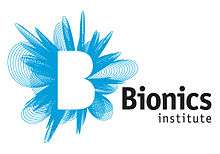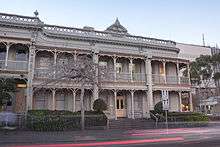Bionics Institute
 The Bionics Institute logo | |
| Motto | From a bionic ear to a bionic era |
|---|---|
| Established | 1984 |
| Mission | Medical translational research |
| Focus | Medical bionics |
| Chairman | John Stanhope AM |
| Director | Professor Robert K. Shepherd |
| Faculty | |
| Adjunct faculty | |
| Staff | approx. 60 |
| Budget | A$7.132 million (2015) |
| Formerly called | Bionic Ear Institute |
| Location | 384-388 Albert Street, East Melbourne, Victoria, Australia |
| Coordinates | 37°48′32″S 144°58′41″E / 37.809°S 144.978°ECoordinates: 37°48′32″S 144°58′41″E / 37.809°S 144.978°E |
| Website |
bionicsinstitute |
| [1] | |
The Bionics Institute is a biomedical research institute focusing on medical bionics. The Institute’s three core research themes are bionic hearing through cochlear implants, bionic vision through stimulation of the optic nerve and neurobionics through deep brain stimulation. The Bionics Institute is located in Melbourne, Australia.
The Institute is dedicated to translational research leading to clinical outcomes. Recent examples of clinical trials the Institute has been involved in include deep brain stimulation of a patient with intractable obsessive compulsive disorder; completion of the Bionic Vision Australia trial of the prototype bionic eye with a trial of the next generation device to commence in 2015;[2] and ongoing evaluation of a novel stimulation method to improve speech perception in five cochlear implant patients.

History
The Bionic Ear Institute was founded in 1984 by Graeme Clark, one of the original developers of the cochlear implant. Professor Clark founded the Institute with the goal of improving the device which he first implanted into a human in 1978. Professor Clark built the Institute into a leading independent cochlear implant research center and was its Director until 2005.
By the early 2000s the Institute was working towards projects outside of hearing and in 2005 and 2007 received significant philanthropic grants totaling $1.5m to undertake a proof-of-concept study into a bionic eye. It was primarily the success of this study that led to a 2009 grant of $42 million from the Australian Research Council to fund the Bionic Vision Australia consortium which was tasked with developing two bionic eye designs in Australia.[3]
In June 2011 the Bionic Ear Institute renamed itself the Bionics Institute to reflect its broader focus which included research into deep brain stimulation, bionic vision and continued work in hearing.
Rob Shepherd became director after Clark’s departure in 2005. Positions on the Bionics Institute Board have been held by ballet dancer and author Li Cunxin, and former Victorian Premier Steve Bracks.
Location
The Bionics Institute has two campuses, one located in East Melbourne and the other in nearby Fitzroy. Mollison House (East Melbourne) is the site of the Institute's administrative team as well as the bulk of its human research. The second campus exists in the Daly Wing of St Vincent's Hospital, Melbourne which houses the Institute's wet labs and materials fabrication facilities.[4]
Research
The Bionics Institute's research follows three primary themes: bionic hearing, bionic vision, and deep brain stimulation.
Bionic hearing
The Institute undertakes bionic hearing research in four main project areas:[5]
- Improving clinical outcomes for hearing-impaired children and adults – Automatic programming for cochlear implants, predicting the benefit gained with hearing devices, improving music perception and appreciation in hearing device users, and improving cochlear implants through novel stimulation strategies,
- Understanding the hearing brain – opening windows on the listening brain, and measuring and harnessing brain plasticity to improve hearing device benefit.
- Preventing progressive hearing loss, and
- Treating other inner ear disorders
Bionic vision
Bionic vision research is undertaken as part of Bionic Vision Australia primarily in two areas: firstly, to support the separate research and development of the supra-choroidal wide-view and epiretinal high acuity devices. Being novel implanted medical devices, each requires substantial commitment from a large multidisciplinary team. Other research into bionic vision relates to computer simulation of retina and brain neurons to electrical stimulation. Increasing device resolution with the use of current steering and psychophysical research into implantee percepts of electrical stimulation are two other key research areas.
Neurobionics
Neurobionics research at the Institute primarily relates to the treatment of nervous system disorders with deep brain stimulation (DBS). The aim of the Institute’s deep brain stimulation research program is to improve the performance of existing DBS devices, gain a greater understanding of how positive therapeutic outcomes are achieved through DBS, and to develop its own advanced DBS system based on cochlear type implant technology. To this end, the Institute has active projects in stimulation for control of Parkinson's disease, essential tremor, movement disorders, and obsessive compulsive disorder. Similarly, the Institute is developing an epilepsy treatment device, which monitors the electrical activity of the brain and delivers a therapeutic stimulus when abnormal activity is detected.
Staffing
Institute Staff are recruited from disciplines including neuroscience, psychophysics, medicine, electrical and acoustic engineering, signal processing, and computer science. Past experience with the cochlear implant platform is the basis upon which much of this present work is being undertaken.
The Bionics Institute also has partnerships with Cochlear Ltd. and its Clinical Research Fellows who are either clinicians or surgeons who work with the Institute on an Honorary basis.
Funding and commercialisation
The Bionics Institute is funded through a combination of government funding, private donations, and contract research. In 2014, the Institute’s annual expenditure was A$7.5 million.[5]
The NHMRC awarded The Bionics Institute grants totalling over A$2 million in the 2014 funding round. Projects in receipt of NHMRC grants include ‘determining the safety and efficiency of the bionic eye’, and ‘restoring binaural processing to bilateral cochlear implant users’.[6]
Bionic Enterprises is a wholly owned subsidiary of the Bionics Institute which focusses on fast-tracked commercialisation of neurobionic devices based on the neuroBi platform with applications for Parkinson's disease, and epilepsy. Bionic Enterprises is part of the Institute’s commercialisation pathway.
In 2015, the Bionics Institute focused towards undertaking contract research in the areas of trial design, rapid prototyping, biocompatibility testing, and other safety and feasibility studies within the field of medical bionics. Contract research represents 4% of the Institute’s annual income as of 2014, but is planned to grow to 15% by 2017.
Collaborations
The Bionics Institute is a member of the Bionic Vision Australia consortium, in which the Institute has a role in electrode prototyping, fabrication, and safety testing, as well as psychophysics to determine clinical outcomes and device utility. Research in conjunction with the Royal Victorian Eye and Ear Hospital is being undertaken to improve inner ear hair cell survival with a long-term goal of regaining inner ear function in hearing-impaired people. In Neurobionics, St Vincent’s Hospital is a partner in projects involving the prediction and treatment of epilepsy using surface recording electrodes and deep brain stimulating electrodes.
The University of Melbourne, Medical Bionics Department
From July 2012, the University of Melbourne School of Medicine and Dentistry created Medical Bionics Department in partnership with the Bionics Institute.[7]
In 2013 the Medical Bionics Department offered its first postgraduate PhD program. The Bionics Institute bestows the Bart Reardon PhD Scholarship annually to support PhD students with research potential that miss out on other scholarship opportunities.
Professor Rob Shepherd is the Head of the Medical Bionics Department of the University of Melbourne.
See also
References
- ↑ "Annual Report 2014-2015" (PDF). Bionics Institute. 2015. Retrieved 4 September 2016.
- ↑ Jennings, Gael; Skafidas, Stan; Ayton, Lauren (10 February 2015). "Bionic vision, diagnostic robots, and nano-tech: engineering and medicine intersect". 774 ABC Melbourne (Interview: audio). Interview with Jon Faine and John Standish. Melbourne, Australia. Retrieved 4 September 2016.
- ↑ Carr, Kim (15 December 2009). "$50 million bionic eye research projects announced" (Press release). Canberra. Retrieved 4 September 2016.
- ↑ "Contact us". Bionics Institute. Retrieved 4 September 2016.
- 1 2 "Annual Report 2013-2014" (PDF). Melbourne: Bionics Institute. 2014.
- ↑ "NHMRC funding announcements and summaries - 2014 grant application round". Canberra: National Health and Medical Research Council (NHMRC). 2014.
- ↑ "Four new departments join medicine, dentistry & health sciences". Melbourne: The University of Melbourne. 24 July 2012. Archived from the original on 9 January 2015.